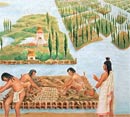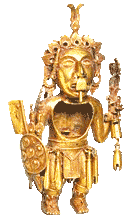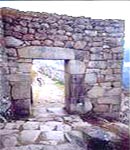New Spain – Old Horrors The plunder of the Americas
The plunder of the empires of the Americas was to good purpose – it allowed Spain to finance religious persecution in Europe for over a century. Spanish wars of conquest included laying waste much of the Netherlands and a disastrous attempt to invade England. By destroying diverse cultures in the New World the Christian conquerors were able not only to eradicate civilizations more ancient than their own but also were able to senselessly erase a vibrant artistic legacy and even scientific knowledge. In their stead the Christian adventurers imposed a racist tyranny and an alien god. Millions were enslaved but their short and brutalized lives had at least known Jesus.
World's Collide: "Reconquista" to "Conquista"


World's Collide: "Reconquista" to "Conquista"
Before the Conquest








Artisans of the Devil?


Dissolute Pope parcels out the Whole World
Ignorant of such distant power broking were perhaps a hundred million indigenous natives of the Americas, blissfully unaware of the unholy crusade about to brutally sweep away their world forever. Across the ocean the cohorts of Christ, having reduced Europe by the carnage of religious warfare, were about to dip their hands in blood in a New World.
The Indies: Christian enthusiasm for "Enjoyment"

Slash and Burn
Destruction
Shock and Awe


Weapons of Mass Destruction
Thrown to the Dogs



Germ warfare
Cultural Genocide

Central America: The Lure of Gold
1697 Martin de Ursua inflicts final defeat of Maya at Tayasal.
South America: Peruvian empire for pious gangsters
1536 Great Inca revolt is followed by resistance in Vilcabamba until 1572 when the last Inca, Tupac Amoru, is captured and executed.
Enslavement: "Slavery is God's mercy" says Christian saint

Genocide
– R. Wright, Stolen Continents, p4.
Regret? Death bed remorse
Cuzco, 18 September 1589 (Wood, p274)
Voice of the Dead
Sources
- Michael Wood, Conquistadors (BBC, 2001)
- Ronald Wright, Stolen Continents – The Indian Story (John Murray, 1992)
- Richard Hart, From Occupation to Independence (University of the West Indies, 1998)
- Hugh Thomas, The Slave Trade – The History of the Atlantic Slave Trade (Picador, 1997)
- Divine, Breen, et al, America – Past and Present (Longman, 1998)
- Noam Chomsky, Year 501 – The Conquest Continues (Verso, 1993
Related articles

16th century Crime scene
The Americas – a prize beyond the dreams of avarice.


New World, Old Crimes
He destroyed it anyway.


'Divine Inca' Atahuallpa sent to Christ
Garden of Eden?
Lost World


Potosi – Mountain Mary of Death
Lost World


Winged Mary of Quito
Fort Jesus

